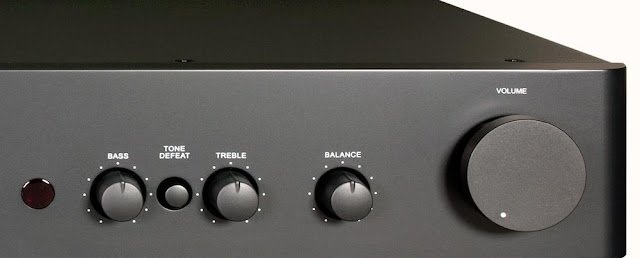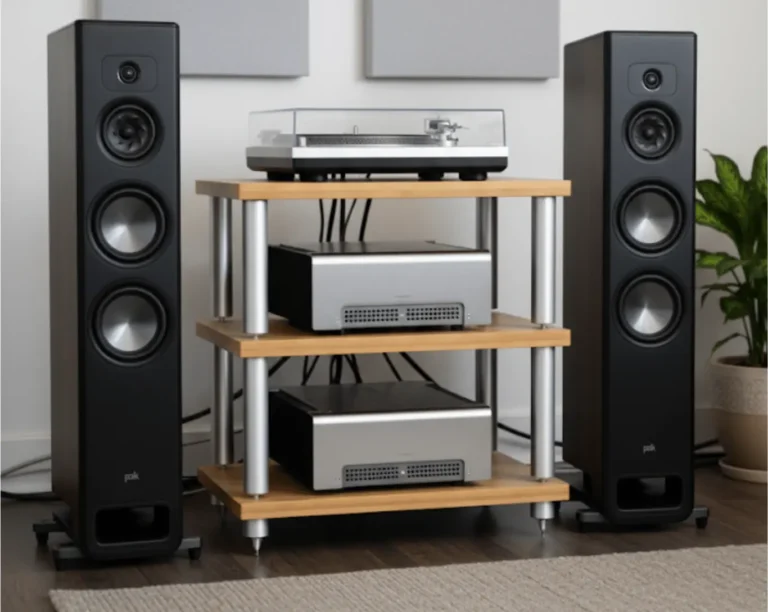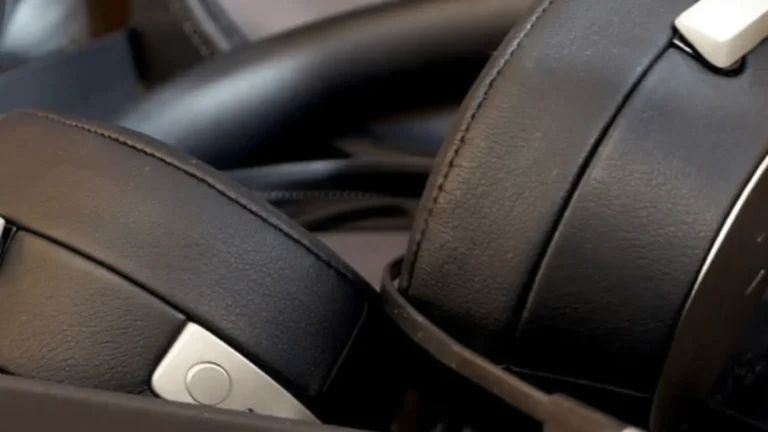NAD C 316BEE V2 Review
At NAD, too, most of the new amplifiers are somehow digital. But only most. With the NAD C 316BEE V2, the inventors of the budget amp are once again presenting a classic, purely analog entry-level amplifier – even with a phono input. And with an unbelievably juicy, aromatic, and substantial sound.
There are hi-fi testers who, at some poin,t are too sophisticated for amplifiers from the so-called entry-level class – great, then you don’t have to tussle with them for the first test devices. For the author of these lines, it’s almost the other way around: when he hears about a new affordable amp with real hi-fi ambitions, he picks up the phone almost reflexively.
Especially quickly, of course, when the device comes from a brand that is as traditionally gifted in terms of value for money as this one. Because the brand new NAD C 316BEE V2 is not just any cheap amp. It is the youngest incarnation of one of the most important hi-fi devices of all time: In 1978, its ancestor, a certain NAD 3020, ensured that good stereo sound with all the trimmings – dynamics, naturalness, musicality – was no longer reserved for the professor was, but was accessible even for music-loving freshmen.

The main merit of the 3020 and its even more prominent successor, the 3020i, was not the low price of around 350 marks at the time. There was cheap stereo stuff back then, and a lot of it looked a lot more impressive than the flat, nondescript gray NAD power bars with plastic buttons.
What was special about these amps was that they seemed to use their naturally limited resources more cleverly, namely, musically more effectively. Smarter than the competition in its price range, and often smarter than the music laboratories of the hi-fi establishment of the time, staring at buttons, pointers, and sometimes even digital displays.
This would at least prove that one (at least the author) simply cannot describe a small NAD amplifier without first paying homage to the 3020. It just doesn’t work, and god knows there’s been plenty of opportunities, which is pretty much every NAD amp since the mid-90s when the author first started professional testing.
News: NAD Unveils Next-Gen C 379 Amplifier: The Future of Hi-Fi
So let’s tear ourselves away from the overpowering ancestor and jump straight into 2018. And what do we see? On/Off, a row of input selectors and a volume knob. So not what technology insiders in tight shirts with pilot’s glasses painted on the wall and in the newly founded hi-fi magazines as the future of hi-fi.

It’s a basic layout that hasn’t changed for 40 years. The 3020 had already defined very well what a stereo-integrated amplifier needs and what it doesn’t. Only a few things have been added over the years, but many have been refined and perfected. And the small NAD also lost a few things, at least temporarily. At some point, the planners thought the time had come to save on the phono input because hardly anyone needed it anymore. The few remaining vinyl users had to resort to separate preamp boxes, which NAD always had in good quality.

But lo and behold: the C 316BEE V2 has an integrated phono section again, and even a quite serious one, which at first glance looks suspiciously like one of those separate boxes had been disemboweled and the innards implanted in the integrated amplifier. You don’t have it after all – according to the print, the small square piggyback circuit board was unmistakably designed for the 316.
In any case, the effort goes well beyond those minimal solutions consisting of an OP amp and a handful of Cs, Rs, and Ls around it, which one otherwise finds in phono-compatible entry-level amps. And even those didn’t have to be bad, as other minimalist classics taught us: The Rotel RA920AX, for example, was now available for less than 200 marks and could make incredibly beautiful music with a small Thorens player and a pair of cleverly selected two-way speakers.

However, what these very small favorite amps usually had very clearly were dynamic limits. Aware Rotel, for example, had an ideal volume range somewhere around 10-11 o’clock on the suspiciously smooth-running (because it was small and unencapsulated) volume control. Below that, the warm-musical magic quickly disappeared into randomness; above that, the warmth gradually became a slightly throaty sound and then pure, bubbling mud. That’s why hardly anyone missed a remote control: Once you had adjusted the ideal volume window at the beginning of a record, there was little room for maneuver anyway.
What distinguishes older NADs and especially the new NAD C 316BEE V2 from such really small amps is their incredible enthusiasm, which makes the listener believe that they are dealing with a much larger amplifier. The comfort zone, in which this amp makes music expressively, rousingly, and with easy-going authority, extends almost as far at the top as with really big amps – and in many cases starts even earlier at the bottom.
In this respect, the NAD maintains the strength of good, low-watt colleagues: Even at room volume, everything works together correctly, and already has elegant momentum and drive, whereas watt cars with their multiple pairs of transistors are sometimes still quite indecisive, but also like to appear thin-lipped and stiff.
Don’t get me wrong: there are, of course, also powerhouses that play perfectly quietly, but they can usually be found in completely different price ranges. The peculiarity of the NAD is that in the blind test, it is considered to be just such a multi-talented rarity. It doesn’t sound like a $400 amp. He sounds pretty huge and yet contoured, muscular, and at the same time finely moved, casual, and highly accurate. He juggles his limited resources so skillfully
The secret of the unexpectedly great sound is, in addition to an amplifier circuit that has been refined over many years and bred for natural distortion behavior on real loads, the daringly designed power supply unit, which offers the output transistors a very high supply voltage. So high that the power semiconductors would soon die of heat death under constant full throttle, like a British classic car on the motorway.
But there is no silicon meltdown because the power supply of the NAD C 316BEE V2 reliably turns off the voltage tap beforehand: The transformer does not deliver one, but two different voltages. The smaller one is designed to withstand full throttle, so the amp is never in danger, even with power-hungry speakers and fully turned up.
The larger one, on the other hand, is always ready, but only for a short time: impulses from snare or bass drum, clicking double bass strings, or crisp piano strokes can draw on the full. The heavily compressed mainstream rock clipping sausage turned up to party level, on the other hand, has to make do with the reduced operating voltage … which of course is still sufficient for a very decent 40 watts at 8Ω.

Technically, the double supply of the NAD C 316BEE V2 is very simple and at the same time ingeniously implemented. The turbo voltage comes from a second secondary winding of the toroidal transformer, including a separate rectifier, and is connected to the output stage via two halogen lamps (one each for plus and minus voltage).
The filaments of the lamps serve as a current-dependent resistor: high continuous currents cause them to glow and thus make them highly resistive, and the voltage drops, in extreme cases, down to the level of the normal, directly connected voltage.
On the other hand, during short current peaks, the tungsten filaments remain dark, their resistance low, and the voltage tap wide open, allowing the amplifier to deliver unusually high pulse power without any risk. At typical hi-fi levels, the lamps were completely off; the images in the following slide show were created with a 120 Hertz sine wave at a permanently higher level on a 4-ohm box. And this is what it looks like:
The user does not notice anything from this “Power Drive” power supply apart from the already mentioned, remarkably high dynamics. The lamps are encapsulated light-tight and last practically forever in normal operation. And even if they were to burn out one day, the NAD C 316BEE V2 would remain operational until they were replaced, just as a “normal” amplifier without a power drive.
The NAD C 316BEE V2 in a listening test
Even then, his loving fine-tuning would still come into play, which gives voices just the right amount of articulation, breathes volume and intelligibility into them at the same time, and, when in doubt, always prefers to deviate in the direction of warmth and fullness. In this way, even problematic recordings can be listened to without any stress, and the really good productions grow into an amazing format.
“Amsterdam Stranded” by Midnight Choir, for example, with its believable piano standing in the room, the acoustics neatly circumscribed around it, and Paal Flaata’s voice, in all its noble lamentation, captured with absolutely no effects.
Played on the Rega Planar 6 with Ortofon 2M Bronze and monitored on the Heco Direct Harmony, the album became a musical and audiophile celebration with a wide studio space, convincingly catchy reproduction, via the NAD and the grandiose Heco Direct Harmony, which was mainly used for listening. Above all, however, musically rousing intensity.
You just wanted to keep listening and not even think about possible improvements. Which, of course, was possible – if only for at least twice as much money.
Twice as much, at the very least. Because that’s what the Rega Brio costs, with the right speakers, it’s an exceptional amplifier in the class up to 1,000 euros. If you switched to the Rega amp, the room seemed more precisely focused, the bass drier and more powerful. And the strings moved forward from the diffuse background into the limelight.
If you increased the price to three times that by connecting the 1,300 euro Marantz PM-8006, the focus no longer improved, but the tonal colors now seemed even richer, and Flaata’s voice in particular seemed to sound even fuller and more engaging.
So the NAD means no danger for well-made amps that cost twice or three times the price, at least as long as you have the possibility of a direct comparison. But what he manages to do is to come astonishingly close to these amps on a lot of records – much closer than you would have ever thought a 400-euro amp could do.
It is pleasing that the phono input also maintains this high level. Only in comparison to really high-end separate equalizer preamps such as the Natalija from Rike Audio, which was connected as a test, does the NAD input appear a bit dark and narrow.
Indeed, the author would recommend this German, completely transistor-free 2,600-euro preamp to an LP-heavy listener as the first upgrade based on the starting point NAD- Heco – Planar 6. Because, as is so often the case with phono stage upgrades, the sound gain here is clearer than if you put a comparable sum into a larger integrated amplifier.
Don’t worry – the NAD just grows with them, and the result then lies somewhere between impressive and surreal: enormously energetic and clear, obviously much closer to the true potential of the LPs.
Oversized phono preamps are and always have been a hot tip for record listeners. With amps as affordable as stretchable as the NAD C 316BEE V2, they are more affordable than ever. Nobody believes the author anyway, but maybe there is an intrepid dealer who can demonstrate it.
Where the Rike Audio is not available, a phono pre from Audio Research, Aesthetix, Roksan, Naim, or Linn can, of course, serve as a replacement – the main thing is that it is bombastic and costs many times more than the integrated amplifier that follows.
The connection options
In terms of equipment, the small NAD leaves nothing to be desired. Balance and tone controls are, of course, available, whereby the latter can be completely swept out of the signal path using the “Tone Defeat” button.
There are more than enough inputs: in addition to the, as already mentioned, very decent phono input, there are five line inputs, one of which is a 3.5mm jack on the front panel – so the portis you have brought with you can be connected to the system quickly and without much fiddling. There is a headphone output, which, however, branches off its signal via a voltage divider directly at the output stage and does not sound great.
And you can connect a pair of speaker wires to solid, banana-sized screw terminals. That’s it. There are no recording or pre-amp outputs at all, even if the developers have kept a pre-out and main-in option open when designing the circuit board. There are correspondingly labeled taps on the mainboard, but they were not used.
Pre-Out and Main In… The blissful 3020 still had these two pairs of sockets, including plug-in connection brackets, after which you could use the amp purely as a power amp or as a pre-amp for external power amps and active speakers, and processors and equalizers of all kinds could be looped in.
If you still need it today, you can get it from the NAD C 316BEE V2’s big brother, the C 326BEE, which also has a little more power and an even more sophisticated power drive circuit, but no phono.
If you are already controlling a maximalist phono chain with a deliberately chosen budget imbalance in favor of the analog sound, you can of course whistle on the missing phono input. On the other hand, the best possible turntable and a non-consumptive pair of speakers are even more important in the first step, and the resulting system has its charm in its clarity.
Price NAD C 316BEE V2
As of May 2025, the NAD C 316BEE V2 stereo integrated amplifier price is USD 499.00, depending on the retailer and region. Prices may vary due to promotions, taxes, or shipping costs.
Conclusion:
The NAD C 316BEE V2 is a solid contender in the realm of budget-friendly integrated amplifiers. Its combination of clear sound, solid build quality, and affordability makes it a compelling option for those seeking an entry into high-fidelity audio. While the limited connectivity might be a drawback for some, its excellent audio performance and phono input make it a great choice for vinyl enthusiasts or anyone looking to elevate their audio setup without spending a fortune.
Overall, the NAD C 316BEE V2 is a worthy investment for those looking for an uncomplicated yet powerful amplifier that delivers an enjoyable listening experience at a reasonable price.
Pros And Cons For NAD C 316BEE V2
Pros:
- Excellent Sound Quality: Warm and engaging audio performance with a well-defined soundstage.
- User-Friendly Design: Intuitive controls and a straightforward layout make it easy to operate.
- Solid Build Quality: Sturdy construction that feels durable and reliable.
- Versatile Connectivity: Multiple inputs, including a dedicated phono stage for turntables.
- Great Value: High performance at an accessible price point.
Cons:
- Limited Power Output: While suitable for most setups, it may struggle with very low-efficiency speakers in larger rooms.
- Basic Features: Lacks advanced features like built-in streaming or Bluetooth, which some competitors may offer.
FAQs NAD C 316BEE V
1. What is the power output of the NAD C 316BEE V2?
The NAD C 316BEE V2 delivers 40 watts per channel into 8 ohms and 60 watts per channel into 4 ohms, providing ample power for most speakers.
2. Does the NAD C 316BEE V2 have a built-in DAC?
No, the C 316BEE V2 does not have a built-in DAC. It focuses on analog inputs, but you can connect an external DAC to the line-level inputs if needed.
3. Can I connect a turntable to the NAD C 316BEE V2?
Yes, the amplifier includes a dedicated phono input with a built-in phono stage, allowing you to connect your turntable directly.
4. How many inputs does the NAD C 316BEE V2 have?
The C 316BEE V2 has four line-level inputs, a dedicated phono input, and a headphone output, providing versatile connectivity options.
5. What type of speakers work best with the NAD C 316BEE V2?
The amplifier pairs well with a variety of speakers, but it is particularly suitable for medium to high-efficiency speakers, as it may struggle with very low-efficiency models in larger rooms.
6. Is the NAD C 316BEE V2 suitable for home theater systems?
While primarily designed for stereo audio, the C 316BEE V2 can be integrated into a home theater system for front channel amplification. However, it lacks surround sound processing.
7. Does the amplifier come with a remote control?
Yes, the NAD C 316BEE V2 has a remote control, which allows for convenient operation from a distance.
8. How does the sound quality compare to other amplifiers in its price range?
The C 316BEE V2 is known for its warm, detailed sound and excellent clarity, making it a strong competitor in the entry-level amplifier market.
9. Is the NAD C 316BEE V2 easy to set up?
Yes, the setup is straightforward. You’re ready to enjoy your music by connecting your audio sources, speakers, and power.
10. How do I maintain the NAD C 316BEE V2?
Regular maintenance involves ensuring proper ventilation, cleaning the exterior, and checking connections. The amplifier does not require tube replacement, as it uses solid-state components.







